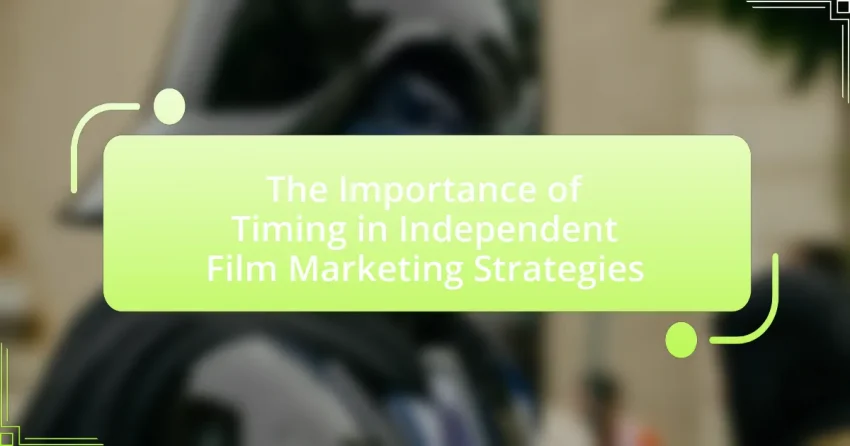The article focuses on the critical role of timing in independent film marketing strategies, emphasizing how it affects audience engagement and box office performance. It outlines the importance of aligning marketing efforts with key industry events, such as film festivals and seasonal trends, to maximize visibility and interest. The article also discusses the consequences of poor timing, including financial losses and reduced audience engagement, while providing practical tips for filmmakers to effectively plan their marketing timelines. Key considerations include monitoring audience engagement metrics, avoiding competition with major releases, and utilizing social media trends to enhance promotional efforts.

What is the Importance of Timing in Independent Film Marketing Strategies?
Timing is crucial in independent film marketing strategies as it directly influences audience engagement and box office performance. Effective timing ensures that marketing efforts align with key industry events, such as film festivals or award seasons, which can significantly enhance visibility and interest. For instance, launching a marketing campaign just before a major festival can capitalize on heightened media attention and audience anticipation, leading to increased ticket sales. Additionally, research indicates that films released during specific periods, like summer or holiday seasons, tend to perform better due to higher audience availability. Therefore, strategic timing in marketing not only maximizes reach but also optimizes the potential for financial success.
Why is timing crucial in the marketing of independent films?
Timing is crucial in the marketing of independent films because it directly influences audience engagement and box office performance. The release schedule must align with film festivals, holidays, or significant cultural events to maximize visibility and interest. For instance, films released during major festivals like Sundance or Cannes often gain critical attention and distribution deals, enhancing their marketability. Additionally, research indicates that films released during peak viewing seasons, such as summer or holiday periods, tend to perform better financially, as audiences are more likely to attend theaters during these times. Therefore, strategic timing can significantly impact the success of independent films in a competitive market.
What are the key timing considerations for independent film releases?
Key timing considerations for independent film releases include aligning the release date with film festivals, avoiding competition with major studio releases, and capitalizing on seasonal trends. Film festivals, such as Sundance or Cannes, provide significant exposure and can enhance a film’s credibility if released in conjunction with them. Additionally, independent films should avoid weekends dominated by blockbuster releases to maximize audience reach. Seasonal trends, such as holiday periods or summer vacations, can also influence audience availability and interest, making it crucial to strategically select release dates that optimize viewership potential.
How does timing influence audience engagement and interest?
Timing significantly influences audience engagement and interest by determining when content is released and how it aligns with audience availability and preferences. For instance, research shows that films released during holidays or major events tend to attract larger audiences due to increased leisure time and heightened interest in entertainment. A study by the Motion Picture Association indicates that films released during summer months often see higher box office revenues, as audiences are more likely to attend theaters during this period. Additionally, social media engagement peaks at specific times, suggesting that posting promotional content when audiences are most active can enhance visibility and interaction. Thus, strategic timing in marketing can directly correlate with audience engagement levels and overall interest in independent films.
What are the consequences of poor timing in film marketing?
Poor timing in film marketing can lead to significant financial losses and reduced audience engagement. When a film is marketed too early, it risks losing momentum and audience interest by the time of release, as seen with films like “The Lone Ranger,” which suffered from prolonged marketing campaigns that diluted excitement. Conversely, marketing too late can result in missed opportunities for building anticipation, as demonstrated by “The Last Duel,” which had a limited promotional window and underperformed at the box office. Additionally, poor timing can lead to clashes with competing releases, further diminishing a film’s visibility and potential earnings. Historical data indicates that films released during crowded periods often see lower box office returns, emphasizing the critical nature of strategic timing in marketing efforts.
How can misjudged timing affect box office performance?
Misjudged timing can significantly impact box office performance by leading to poor audience turnout and reduced revenue. For instance, releasing a film during a crowded market period, such as major holidays or alongside blockbuster films, can overshadow an independent film, resulting in lower ticket sales. Historical data shows that films released during off-peak times often perform better, as they face less competition; for example, “The Blair Witch Project” was released in July 1999, a relatively quiet month, which contributed to its box office success, grossing nearly $250 million worldwide against a budget of $60,000. Therefore, strategic timing is crucial for maximizing audience engagement and financial returns in independent film marketing.
What are the long-term impacts of ineffective marketing timing?
Ineffective marketing timing can lead to significant long-term impacts, including reduced audience engagement and diminished brand reputation. When marketing campaigns are poorly timed, they may miss key opportunities to connect with target audiences, resulting in lower ticket sales and reduced visibility for independent films. For instance, launching a campaign during a crowded release window can lead to overshadowing by larger films, causing the independent project to be overlooked. Additionally, consistent misalignment in timing can erode consumer trust, as audiences may perceive the brand as out of touch or unresponsive to market trends. This can ultimately hinder future marketing efforts and limit the film’s potential for success in subsequent releases.

How can filmmakers effectively plan their marketing timelines?
Filmmakers can effectively plan their marketing timelines by establishing a clear schedule that aligns with key milestones in the film production and release process. This involves creating a timeline that includes pre-production, production, post-production, and distribution phases, ensuring that marketing efforts are strategically timed to build audience anticipation and engagement. For instance, research indicates that films with a well-structured marketing timeline can increase audience awareness by up to 50% before release, as seen in successful campaigns like “The Blair Witch Project,” which utilized a staggered marketing approach to generate buzz. By integrating marketing activities such as social media promotions, press releases, and festival screenings into this timeline, filmmakers can maximize their outreach and impact.
What steps should filmmakers take to create a marketing timeline?
Filmmakers should begin by defining key milestones for their project, including pre-production, production, and post-production phases. Next, they should establish a timeline that outlines specific marketing activities aligned with these milestones, such as teaser releases, social media campaigns, and festival submissions. Additionally, filmmakers must allocate resources and assign responsibilities to team members for each marketing activity to ensure accountability. Finally, they should regularly review and adjust the timeline based on project developments and audience engagement metrics to optimize marketing effectiveness. This structured approach is supported by industry practices that emphasize the importance of timely marketing efforts in maximizing audience reach and engagement.
How do pre-release, release, and post-release phases differ in timing strategies?
Pre-release, release, and post-release phases differ significantly in timing strategies, with each phase focusing on distinct objectives and audience engagement tactics. During the pre-release phase, marketing strategies prioritize building anticipation and awareness, often utilizing teasers, trailers, and social media campaigns to generate buzz before the film’s debut. In contrast, the release phase emphasizes maximizing visibility and attendance, employing strategies such as premiere events, press screenings, and targeted advertising to capture immediate audience interest. Finally, the post-release phase shifts focus to sustaining interest and encouraging word-of-mouth, often through follow-up marketing efforts, audience engagement on social media, and leveraging reviews to maintain momentum. These timing strategies are crucial for optimizing audience reach and maximizing box office performance, as evidenced by successful independent films that have effectively utilized these phased approaches to enhance their market impact.
What tools can assist in planning marketing timelines for independent films?
Project management software such as Trello, Asana, and Monday.com can assist in planning marketing timelines for independent films. These tools allow filmmakers to create detailed timelines, assign tasks, and track progress, ensuring that all marketing activities are organized and executed on schedule. For instance, Trello uses boards and cards to visually represent tasks, making it easy to see what needs to be done and when. Asana offers timeline views that help in visualizing project deadlines and dependencies, which is crucial for coordinating marketing efforts effectively. Additionally, Monday.com provides customizable workflows that can adapt to the specific needs of film marketing campaigns, enhancing collaboration among team members.
How can filmmakers adapt their strategies based on market trends?
Filmmakers can adapt their strategies based on market trends by analyzing audience preferences and box office performance data. For instance, tracking the rise of streaming platforms has led many filmmakers to prioritize digital distribution and tailor content for on-demand viewing, as evidenced by the significant increase in streaming service subscriptions during the COVID-19 pandemic, which saw a 50% rise in viewership for platforms like Netflix. Additionally, filmmakers can utilize social media analytics to gauge audience engagement and adjust marketing campaigns accordingly, ensuring that promotional efforts align with current viewer interests and behaviors. This data-driven approach allows filmmakers to remain competitive and relevant in a rapidly evolving industry.
What indicators should filmmakers monitor to adjust their marketing timing?
Filmmakers should monitor audience engagement metrics, social media trends, and competitor release schedules to adjust their marketing timing. Audience engagement metrics, such as likes, shares, and comments on promotional content, indicate the level of interest and can signal optimal times for intensified marketing efforts. Social media trends, including hashtags and viral content related to similar genres, provide insights into current viewer preferences and can inform strategic timing for campaigns. Additionally, tracking competitor release schedules helps filmmakers avoid clashes with similar films, ensuring their marketing efforts reach the target audience effectively. These indicators collectively guide filmmakers in optimizing their marketing strategies for maximum impact.
How can social media trends influence marketing timing decisions?
Social media trends can significantly influence marketing timing decisions by providing real-time insights into audience interests and behaviors. Marketers can analyze trending topics, hashtags, and engagement metrics to determine optimal moments for launching campaigns or promotions. For instance, a study by Sprout Social found that 70% of consumers are more likely to engage with brands that align their messaging with current social media trends. This alignment can enhance visibility and relevance, ultimately leading to increased audience engagement and sales.

What are the best practices for timing in independent film marketing?
The best practices for timing in independent film marketing include planning marketing efforts around key milestones such as film festivals, release dates, and audience engagement opportunities. Effective timing ensures that promotional activities align with the film’s lifecycle, maximizing visibility and audience interest. For instance, launching a marketing campaign several months before a film festival can build anticipation and leverage the festival’s audience. Additionally, utilizing social media and online platforms during peak engagement times can enhance outreach. Research indicates that films marketed with strategic timing around events see a 30% increase in audience turnout compared to those without a structured timeline.
How can filmmakers optimize their marketing efforts through timing?
Filmmakers can optimize their marketing efforts through timing by strategically scheduling promotional activities to align with key industry events and audience engagement periods. For instance, launching a marketing campaign during major film festivals, such as Sundance or Cannes, can significantly increase visibility, as these events attract media attention and industry professionals. Additionally, timing releases to coincide with relevant holidays or cultural moments can enhance audience interest; for example, horror films often perform better when released around Halloween. Research indicates that films released during peak viewing seasons, such as summer or the winter holidays, tend to achieve higher box office revenues, as audiences are more likely to attend theaters during these times. By analyzing audience behavior and industry trends, filmmakers can effectively time their marketing initiatives to maximize reach and impact.
What are the most effective timing strategies for film festivals?
The most effective timing strategies for film festivals include selecting optimal submission deadlines, aligning with industry trends, and scheduling screenings to maximize audience attendance. By adhering to submission deadlines, filmmakers ensure their films are considered for prestigious festivals, which often have specific windows for entries. Aligning festival dates with major industry events, such as the Cannes Film Festival coinciding with the European film market, enhances visibility and networking opportunities. Additionally, scheduling screenings during peak times, such as weekends or evenings, increases the likelihood of attracting larger audiences, as evidenced by attendance patterns observed at various festivals.
How can seasonal trends impact marketing timing for independent films?
Seasonal trends significantly impact marketing timing for independent films by influencing audience availability and preferences. For instance, summer months often see increased cinema attendance due to school vacations, making it an ideal time for releases targeting family audiences. Conversely, the holiday season can be advantageous for films with themes of family and togetherness, as audiences are more inclined to seek entertainment during this period. Data from the Motion Picture Association indicates that box office revenues peak during these seasons, underscoring the importance of aligning marketing efforts with these trends. Additionally, festivals and award seasons can create buzz, prompting strategic release dates that capitalize on heightened public interest.
What common pitfalls should filmmakers avoid regarding timing?
Filmmakers should avoid the pitfall of poor scheduling, as it can lead to rushed production and compromised quality. Effective timing is crucial for aligning shooting schedules with optimal weather conditions, actor availability, and location access. Additionally, filmmakers must be cautious of releasing their films during crowded market periods, which can dilute audience attention and reduce box office performance. Historical data shows that films released during less competitive times often achieve higher box office returns, emphasizing the importance of strategic timing in marketing.
How can filmmakers prevent over-saturation in their marketing efforts?
Filmmakers can prevent over-saturation in their marketing efforts by strategically timing their promotional activities and diversifying their marketing channels. By scheduling marketing campaigns to coincide with key milestones, such as film festivals or release dates, filmmakers can maintain audience interest without overwhelming them. Research indicates that campaigns that utilize a mix of social media, traditional advertising, and targeted outreach can effectively engage audiences without causing fatigue. For instance, a study by the American Marketing Association found that varied marketing approaches can increase audience retention and engagement by up to 30%, demonstrating the effectiveness of a balanced strategy.
What are the risks of delaying marketing campaigns?
Delaying marketing campaigns poses significant risks, including lost revenue opportunities and diminished audience engagement. When campaigns are postponed, potential customers may lose interest or turn to competitors, leading to decreased ticket sales or viewership. For instance, a study by the American Marketing Association found that timely marketing can increase consumer interest by up to 30%, highlighting the importance of aligning promotional efforts with audience readiness. Additionally, delays can disrupt the momentum built around a film’s release, resulting in a weaker overall impact and reduced brand visibility.
What practical tips can filmmakers implement for effective timing in marketing?
Filmmakers can implement several practical tips for effective timing in marketing by strategically planning their promotional activities around key milestones. First, they should align marketing campaigns with film festival submission deadlines, as early buzz can attract attention from distributors and audiences. For instance, launching a teaser trailer shortly before a major festival can maximize visibility and engagement.
Additionally, filmmakers should consider the release schedule of competing films to avoid clashes that could dilute audience interest. Research indicates that films released during holiday seasons or summer months often see higher box office returns due to increased audience availability.
Moreover, utilizing social media analytics to identify peak engagement times can enhance the effectiveness of promotional posts. Studies show that posts made during high-traffic periods receive significantly more interaction, which can lead to greater audience reach.
Finally, filmmakers should maintain a consistent marketing timeline that builds momentum leading up to the film’s release, ensuring that audiences remain engaged and informed throughout the process. This approach has been validated by successful independent films that have effectively utilized staggered marketing tactics to sustain interest.
